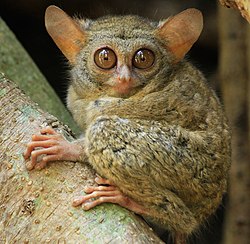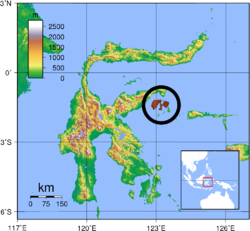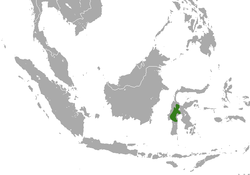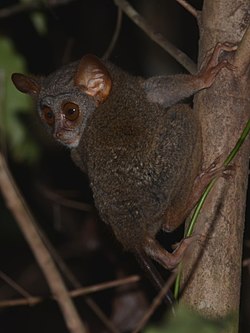| Common name | Scientific name and subspecies | Range | Size and ecology | IUCN status and estimated population |
|---|
| Dian's tarsier
| T. dentatus
Miller & Hollister, 1921 | Central Sulawesi, Indonesia
 | Size: 11–12 cm (4–5 in) long, plus 13–28 cm (5–11 in) tail [2] [3]
Habitat: Forest [4]
Diet: Insects, as well as small vertebrates [2] | VU
Unknown  [4] [4]
|
|---|
| Gursky's spectral tarsier  | T. spectrumgurskyae
Shekelle, Groves, Maryanto & Mittermeier, 2017 | Northeastern Sulawesi (in purple)
 | Size: About 14 cm (6 in) long, plus 21–27 cm (8–11 in) tail [5]
Habitat: Forest [6]
Diet: Insects, as well as small vertebrates [6] | VU
Unknown  [6] [6]
|
|---|
| Jatna's tarsier
| T. supriatnai
Shekelle, Groves, Maryanto & Mittermeier, 2017 | Northern Sulawesi (in gray)
 | Size: About 14 cm (6 in) long, plus 23–25 cm (9–10 in) tail [5]
Habitat: Forest [7]
Diet: Insects, as well as small vertebrates [7] | VU
Unknown  [7] [7]
|
|---|
| Lariang tarsier
| T. lariang
Groves & Merker, 2006 | Central Sulawesi
 | Size: About 12 cm (5 in) long, plus 12–21 cm (5–8 in) tail [8]
Habitat: Forest [9]
Diet: Insects, as well as small vertebrates [9] | DD
Unknown  [9] [9]
|
|---|
| Makassar tarsier  | T. fuscus
Fischer von Waldheim, 1804 | Southern Sulawesi (in yellow)
 | Size: 12–13 cm (5 in) long, plus 24–26 cm (9–10 in) tail [10]
Habitat: Forest and caves [11]
Diet: Insects, as well as small vertebrates [10] | VU
Unknown  [11] [11]
|
|---|
| Niemitz's tarsier
| T. niemitzi
Shekelle, Groves, Maryanto, Mittermeier, Salim & Springer, 2019 | Northern Sulawesi (circled in black)
 | Size: About 14 cm (6 in) long, plus 24–26 cm (9–10 in) tail [12]
Habitat: Forest [13]
Diet: Insects, as well as small vertebrates [13] | EN
10,000–20,000  [13] [13]
|
|---|
| Peleng tarsier
| T. pelengensis
Sody, 1949 | Eastern Sulawesi
 | Size: 12–14 cm (5–6 in) long, plus 25–27 cm (10–11 in) tail [14]
Habitat: Forest [15]
Diet: Insects, as well as frogs, lizards, and other small vertebrates [15] | EN
Unknown  [15] [15]
|
|---|
| Pygmy tarsier
| T. pumilus
Miller, Hollister, 1921 | Central Sulawesi
 | Size: 8–11 cm (3–4 in) long, plus 20–21 cm (8 in) tail [16] [17]
Habitat: Forest [18]
Diet: Arthropods and insects, as well as small vertebrates [16] | EN
Unknown  [18] [18]
|
|---|
| Sangihe tarsier  | T. sangirensis
Meyer, 1897 | Sangir Island, southeastern Philippines
 | Size: 12–13 cm (5 in) long, plus about 30 cm (12 in) tail [19]
Habitat: Forest and inland wetlands [20]
Diet: Insects, as well as birds, lizards, and other small vertebrates [19] | EN
Unknown  [20] [20]
|
|---|
| Siau Island tarsier  | T. tumpara
Shekelle, Groves, Merker & Supriatna, 2008 | Siau Island, north of Sulawesi | Size: 10–15 cm (4–6 in) long, plus about 20 cm (8 in) tail [21]
Habitat: Forest [22]
Diet: Arthropods, as well as small vertebrates [22] | CR
Unknown  [22] [22]
|
|---|
| Spectral tarsier
| T. tarsier
(Erxleben, 1777) | Sulawesi
 | Size: 9–14 cm (4–6 in) long, plus 20–26 cm (8–10 in) tail [23]
Habitat: Forest [24]
Diet: Insects, as well as lizards, bats, and other small vertebrates [23] | VU
Unknown  [24] [24]
|
|---|
| Wallace's tarsier
| T. wallacei
Merker, Driller, Dahruddin, Wirdateti, Sinaga, Perwitasari-Farajallah & Shekelle, 2010 | Northern Sulawesi (in orange)
 | Size: 11–13 cm (4–5 in) long, plus 23–27 cm (9–11 in) tail [25]
Habitat: Forest and inland wetlands [26]
Diet: Insects, as well as small vertebrates [25] | VU
Unknown  [26] [26]
|
|---|















